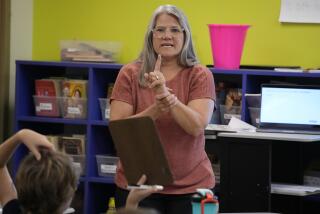Probability Theory
- Share via
Parents who find themselves reduced to a quivering, whimpering mess when they are called upon to help the kids with math homework (“No, please, anything, I’ll increase your allowance tenfold, just get that fraction away from me!”) would do well to look at The Math Kit: A Three-Dimensional Tour Through Mathematics (Scribner’s: $35, hardback, fourth grade and up) .
This parental psyche-saver is a tour de force from Rob Van Der Meer--whose firm gets inside-book credit for “conceived, produced, designed and paper-engineered by Van Der Meer Books Ltd.”--and Bob Gardner, a mathematics instructor. Using a combination of pop-ups, interactive mechanics and pullouts, the pair have managed to pull off what, to this non-Cartesian observer at least, is a pleasant walk through everything from simple multiplication, addition, subtraction and division to simultaneous equations exponents and other lofty subjects.
A taste of what’s to come, the inside cover and first page of “The Math Kit” has a pop-up pyramid with fold-out inserts behind baseball-card like pictures of Egyptians gods and goddesses. The cards hide text that explains the beginnings of math and the Egyptian role in the invention of formal systems, which segues neatly to Page 3 with its pull-tab strip showing how numbers move in place value.
Then there’s the wheel of fractions, the red filter/blue filter glasses to see alternative ways of looking at the same concept, the algebra equation pull-tab folder, the shape and space mobile, the trigonometry shifting angle graphic, the data pictogram/bar chart/pie chart and on and on.
This is not an easy book. I bounced it off one very intelligent mini-reviewer, Jessica Seiler, age 8, and got this response: “I do not recommend this book for kids younger than 9 because it is hard to understand. I am 8 2/3 and I like the pop-ups--they help me understand. But a good section of the book is trigonometry and algebra, which I don’t know about.
“I am going to save this book for when I am older, but for now, the pop-ups will teach me what I need to know.”
Jessica is right; “Math Kit” is probably best for older kids and/or adults. But lest you think none of this could possibly apply to anything “real” or be of interest, the last segment explains probability theory--complete with a mini-set of dice for junior to practice with.
Las Vegas, anyone?
At the opposite end of the spectrum, Anno’s Big Counting Book, written and illustrated by Mitsumasa Anno (HarperCollins: $19.95, paperback, preschool through third grade), is an oversized delight aimed at those just mastering the art of counting on their toes. The watercolor artwork is charming and subtle: The numbers change monthly and the lonely town in January grows with more people, houses, trees and animals until it is fair to busting over in December (June has six of everything and so on). The oversized format is large enough for kids to lie across and really study the pictures if they choose to do so.
Anno also scores with Anno’s Magic Seeds, written and illustrated by Mitsumasa Anno (Putnam & Grosset: $15.95, hardback, ages 4 to 8), a lovely, math-oriented fable about Jack, a man who is given two mysterious magic seeds by a wizard--who also gives him some intriguing advice. Jack takes the wizard’s advice and his fortune grows and grows while the reader tries to keep track and add up the ever-increasing amount of seeds. The text is well-written and deceptively simple and the watercolors nicely capture their creator’s charming touch. All in all, a nice work--and one more proof of the theorem that math can be fun.
More to Read
Sign up for our Book Club newsletter
Get the latest news, events and more from the Los Angeles Times Book Club, and help us get L.A. reading and talking.
You may occasionally receive promotional content from the Los Angeles Times.








